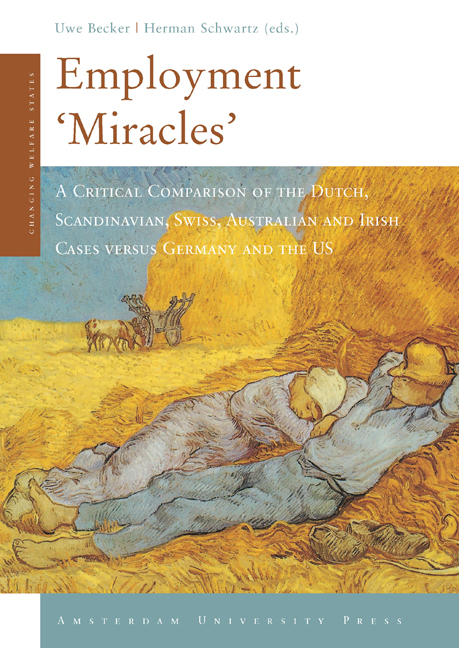 Employment 'Miracles'
Employment 'Miracles' Book contents
- Forntmatter
- Contents
- Preface
- 1 Introduction: Miracles, Mirages and Markets
- 2 The Dutch Model: Magic in a Flat Landscape?
- 3 Employment and Unemployment in Denmark and Sweden: Success or Failure for the Universal Welfare Model?
- 4 The Evolution of the Finnish Model in the 1990s: From Depression to High-Tech Boom
- 5 The Swiss Miracle: Low growth and high employment
- 6 Recasting the Story of Ireland’s Miracle: Policy, Politics or Profit?
- 7 The Australian Miracle: Luck, Pluck or Being Stuck Down Under?
- 8 Last Year’s Model? Reflections on the American Model of Employment Growth
- 9 The German Contrast. On Bad Comparisons, Special Circumstances, Luck and Policies That Turned Out to Be Wrong
- 10 Conclusion: The Importance of Lucky Circumstances, and Still the Liberal-Social Democratic Divide
- Bibliography
- Contributors
- Index
2 - The Dutch Model: Magic in a Flat Landscape?
Published online by Cambridge University Press: 15 January 2021
- Forntmatter
- Contents
- Preface
- 1 Introduction: Miracles, Mirages and Markets
- 2 The Dutch Model: Magic in a Flat Landscape?
- 3 Employment and Unemployment in Denmark and Sweden: Success or Failure for the Universal Welfare Model?
- 4 The Evolution of the Finnish Model in the 1990s: From Depression to High-Tech Boom
- 5 The Swiss Miracle: Low growth and high employment
- 6 Recasting the Story of Ireland’s Miracle: Policy, Politics or Profit?
- 7 The Australian Miracle: Luck, Pluck or Being Stuck Down Under?
- 8 Last Year’s Model? Reflections on the American Model of Employment Growth
- 9 The German Contrast. On Bad Comparisons, Special Circumstances, Luck and Policies That Turned Out to Be Wrong
- 10 Conclusion: The Importance of Lucky Circumstances, and Still the Liberal-Social Democratic Divide
- Bibliography
- Contributors
- Index
Summary
Introduction
Of all the ‘models’ discussed in this volume, the Dutch one is the most famous one – possibly because the Netherlands is not as small as Ireland and Denmark, because it came from far behind, and because it managed to combine spectacular employment growth with competitiveness and the maintenance of a generous, though somewhat retrenched, welfare system. The Netherlands has witnessed a rapid decline in the unemployment rate that brought it to one of the lowest levels of all OECD countries. At the same time, the country's job growth was about the highest in the OECD area (see Chart 2.1); within one and a half decades it had mutated from a country with an employment rate of just over 50 percent to a high employment economy. These developments were regarded as something of a miracle, particularly because previously, between 1975 and the early 1980s, the country was known for the ‘Dutch disease’. Feelings of admiration are aroused by these outcomes because the Netherlands is also thought to have brought this result about by conscious action, and can therefore serve as an example for other countries that do not want to take the liberal, American route. And because corporatism is supposed to have played a crucial role in the Dutch development, the country also serves as a model case in discussions on ‘competitive corporatism’ and ‘new social pacts’. The model image appears to have survived even though Dutch performance lost much of its lustre in the economic downturn after 2002, as the Netherlands fell from the top range to the bottom end of GDP performance among EU member states.
In the early 1990s, despite several years of employment growth, nobody thought about characterising the Netherlands as a model. A rather critical view on the economy prevailed in the Netherlands, where newspapers described corporatism as eroding (de Volkskrant, December 24, 1991; NRC Handelsblad, November 20, 1992). A few years later, scholars of industrial relations still described Dutch corporatism as ‘weak’ (Van Ruysseveldt and Visser 1996; cf. Hemerijck 1995, p.186). At that time, it was hard to imagine that the corporatist Foundation of Labour should receive in 1997 the prestigious Carl Bertelsmann Award ‘for innovative concepts and exemplary proposals for the solution of central socio-political problems’.
- Type
- Chapter
- Information
- Employment 'Miracles'A Critical Comparison of the Dutch, Scandinavian, Swiss, Australian and Irish Cases versus Germany and the US, pp. 39 - 64Publisher: Amsterdam University PressPrint publication year: 2005
- 1
- Cited by


